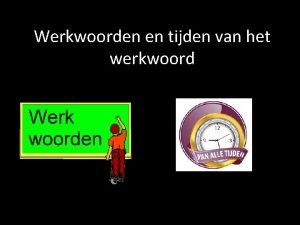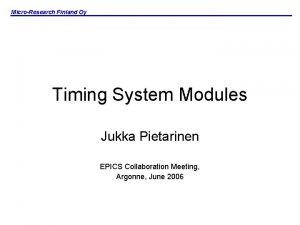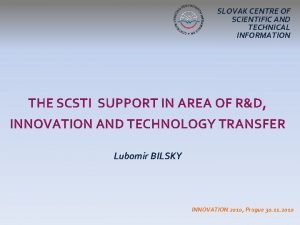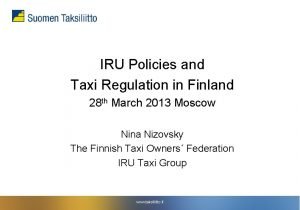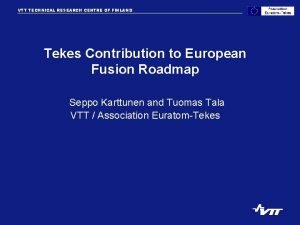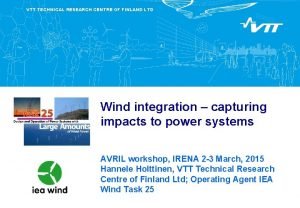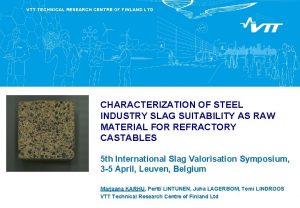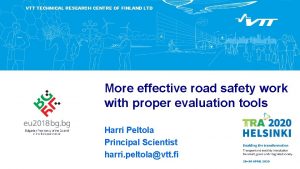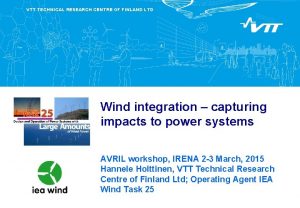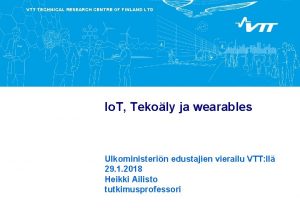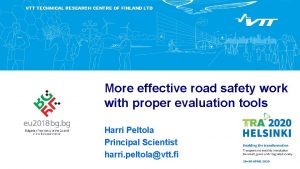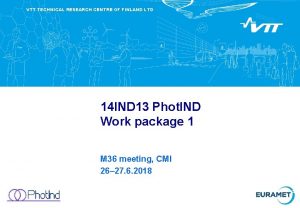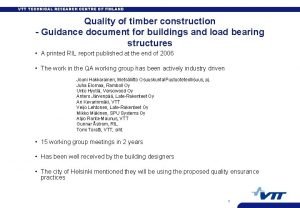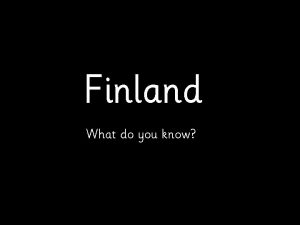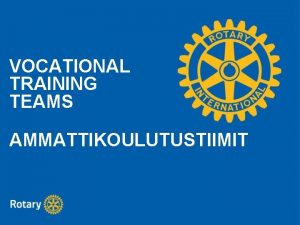VTT TECHNICAL RESEARCH CENTRE OF FINLAND LTD Validation












![Site Classification Site Meteorological icing from Ceilometer [% of time] Meteorological Instrumental icing from Site Classification Site Meteorological icing from Ceilometer [% of time] Meteorological Instrumental icing from](https://slidetodoc.com/presentation_image_h2/c812445bbcb9f386fb4544ba3602e337/image-13.jpg)


- Slides: 15

VTT TECHNICAL RESEARCH CENTRE OF FINLAND LTD Validation of remote sensing methods for ice detection Wind. Europe 2016 Timo Karlsson, VTT

Authors § Timo Karlsson, Ville Lehtomäki, VTT § Juha Paldanius, Vaisala § Jaakko Kleemola, Suomen Hyötytuuli § Martin S. Grønsleth, Kjeller Vindteknikk § Zouhair Khadiri-Yazami, Fraunhofer IWES 28/09/2016 2

Icing and wind power § Ice accretion on turbine blades reduces output power of the turbine § Falling ice is a health and safety risk § Cold climate wind is a substantial market Cumulative installed capacity by end Forecasted capacity by end of 2020 of 2015 [MW] Low temperature Icing 40 500 86 500 62 500 123 000 Total 127 000 Total 185 500 Source: V. Lehtomäki, Emerging from the cold, Wind Power Monthly, 29. 7. 2016 , http: //www. windpowermonthly. com/article/1403504/emerging-cold 28/09/2016 3

Icing types § Icing needs liquid water & freezing temperature § Low level clouds & T<0°C = in-cloud icing (most typical) *Source: IEA Wind Task 19 Available Technologies report of Wind Energy in Cold Climates (2016 edition): http: //www. ieawind. org/task_19. html 28/09/2016 4

IEA Ice Classification¹ Duration of IEA Production Meteorological Instrumental Ice Loss Icing Class [% of AEP] [% of Year] 5 4 3 2 1 >10 5 -10 3 -5 0. 5 -3 0 -0. 5 >20 10 -30 6 -15 1 -9 <1. 5 >20 10 -25 3 -12 0. 5 -5 0 -0. 5 ¹: IEA Wind Recommended Practices for wind energy projects in cold climates edition 2011 28/09/2016 5

Remote ice detection § Use a LIDAR or ceilometer to determine cloud base height § Combine with meteorological measurements to produce warnings of meteorological icing § Measure icing at almost any height with ground based instrument § Create an icing profile for the measurement location 28/09/2016 US Patent 2014/0192356 Arrangement and method for icing detection Esa Peltola, Petteri Antikainen, Andrea Vignaroli 6

Method principle § Lidar measures wind speeds with laser § Light reflected back from particles in air § Cloud->more particles in air-> stronger backscatter signal § Ceilometer Based on Measurement signal same priciple § Ceilometer only measures cloud cover height, not wind speed 28/09/2016 Backscatter signal 7

Sites Site Country Instrumentation Time period Site A Finland Dec 2015 -Apr 2016 Site B Germany Site C Norway Site D Finland 28/09/2016 Vaisala CL 31 ceilometer Wind turbine heated/non-heated anemometers [100 m agl] Leosphere Wind. Cube LIDAR Jenoptik/Lufft CHM 15 K ceilometer Heated/nonheated anemometers [190 m agl] Webcam Leosphere Wind. Cube LIDAR Combitech Ice. Monitor ice detector [90 m agl] webcam Leosphere Wind. Cube LIDAR Vaisala CL 31 Ceilometer Oct 2012 Feb 2014 – Jan 2012 - Jun 2014 Fed 2016 -Jun 2016 8

Data overview 28/09/2016 9

Data overview 28/09/2016 10

Site C Conditions during icing § Instrumental icing most common at § temperatures close to 0 °C § Wind speed < 10 m/s Site A 28/09/2016 Site B 11

Correlation § Correlation between meteorological and instrumental icing measurements § Calulated for different time windows for all sites § Shows that correlation starts to improve only when observation window is long Correlation Coefficient 1 0, 8 0, 6 0, 4 0, 2 0 0 5 10 15 20 25 30 35 Time Step [days] Site B 28/09/2016 Site C Site A 12
![Site Classification Site Meteorological icing from Ceilometer of time Meteorological Instrumental icing from Site Classification Site Meteorological icing from Ceilometer [% of time] Meteorological Instrumental icing from](https://slidetodoc.com/presentation_image_h2/c812445bbcb9f386fb4544ba3602e337/image-13.jpg)
Site Classification Site Meteorological icing from Ceilometer [% of time] Meteorological Instrumental icing from wind icing LIDAR [% of time] Site A 5 %: - 11. 2 %: Site B 3 %: Class 2 (Ceilometer) 1. 8 %: Class 2 (LIDAR) 3. 8 %: Class 2 Site C - 2 %: Class 2 14. 9 %: Class 3 Site D 1. 6 %: 2. 0 %: - § Ice classification hits same class at site B § Site C way under § Availability also very low § From ice sensor meteorological icing § 4. 4 %/class 3 § Ice class requires at least a year of data 28/09/2016 13

Conclusions and future work § Remote sensing of icing looks promising § Availability an issue when using LIDAR § Better during icing than on average. Might still miss events. § Ceilometer no availability issues, also resolution better § Correlation on a longer timescale § Can give an estimate of conditions § No real time detection 28/09/2016 § Improve LIDAR data availability § Cloud composition § Water vapor / ice crystals § Now compares Meteorological icing to instrumental icing § Different reference needed § Better transfer from meteorological to instrumental icing 14

TECHNOLOGY FOR BUSINESS
 Zww en hww
Zww en hww Micro research finland
Micro research finland Jtspl
Jtspl Jts group
Jts group Orchid technical consultancy p ltd
Orchid technical consultancy p ltd Goodhill korea centre pte ltd
Goodhill korea centre pte ltd Validation of instrument in research example
Validation of instrument in research example Headquarter toyota
Headquarter toyota Slovak centre of scientific and technical information
Slovak centre of scientific and technical information Centroid in engineering mechanics
Centroid in engineering mechanics Center of gravity formula for different shapes
Center of gravity formula for different shapes Westmoreland labs
Westmoreland labs Sunrise agriland development & research pvt. ltd.
Sunrise agriland development & research pvt. ltd. What is the origin of the word easter
What is the origin of the word easter Maarit haikonen
Maarit haikonen Taxi license finland
Taxi license finland
